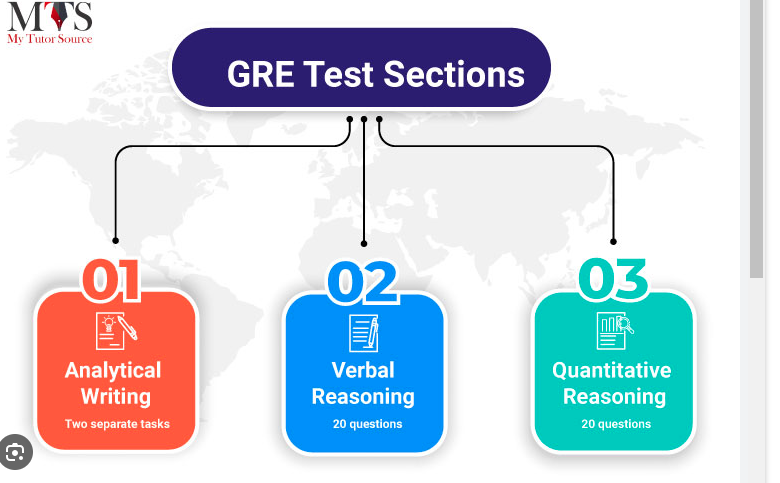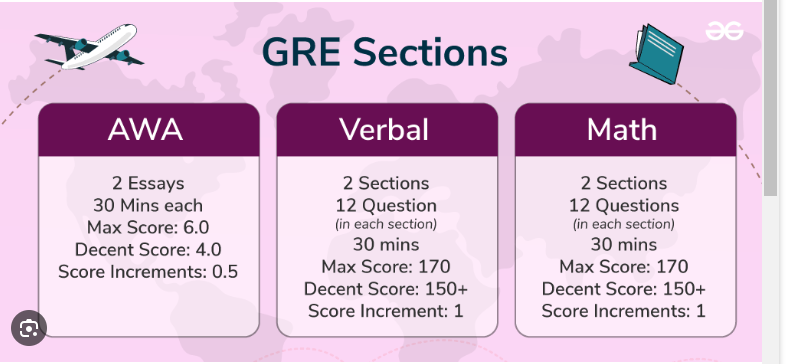Welcome to TakeMyGREExam.com, your one-stop destination for all things related to the GRE. If you’re preparing for the Graduate Record Examinations (GRE), you’ve probably already realized that understanding the exam structure is crucial for success. But don’t worry we’ve got you covered! In this guide, we’ll break down the different sections of the GRE so you can approach your preparation with confidence and ease.
The GRE is designed to assess your readiness for graduate school by evaluating key skills you’ll need in your advanced studies. It’s a standardized test that many graduate programs require as part of the admissions process. Understanding the sections of the GRE and what they entail will help you create a study plan that targets each area efficiently.
The Three Main Sections of the GRE Exam
The GRE consists of three main sections: Verbal Reasoning, Quantitative Reasoning, and Analytical Writing. Each section plays a vital role in testing specific skills necessary for success in graduate school. Let's take a closer look at what each section involves.
1. Verbal Reasoning
The Verbal Reasoning section is designed to measure your ability to analyze and evaluate written material. It also tests how well you understand the meaning of words, sentences, and passages, as well as your ability to reason logically from the information you’re given.
What it includes:
-
Reading Comprehension: You'll read passages and answer questions about their content. This tests your ability to grasp the meaning of what you’ve read and draw inferences from it.
-
Text Completion: These questions involve filling in the blanks of a sentence or passage with the appropriate word or phrase. It measures your vocabulary and how well you understand context.
-
Sentence Equivalence: You’ll need to choose two words that best complete a sentence, both fitting the context and making sense with the sentence structure.
-
Read regularly books, articles, research papers to build your vocabulary and comprehension skills.
-
Practice breaking down complex texts into main ideas and key details.
-
Focus on context clues to decipher unfamiliar words and phrases.
2. Quantitative Reasoning
The Quantitative Reasoning section is designed to measure your mathematical skills, focusing on your ability to reason and solve problems using quantitative methods. Don’t be intimidated if math isn’t your strong suit this section is more about problem-solving and logical reasoning than advanced formulas.
What it includes:
-
Arithmetic: Basic operations like addition, subtraction, multiplication, and division.
-
Algebra: Equations, inequalities, and functions.
-
Geometry: Questions on shapes, areas, volumes, and properties of figures.
-
Data Interpretation: Interpreting data from graphs, tables, and charts.
-
Review basic math concepts and formulas.
-
Practice solving problems step by step, focusing on understanding the underlying principles.
-
Time yourself while practicing to get comfortable with the pace of the test.
3. Analytical Writing
The Analytical Writing section is unique because it evaluates how well you can express your ideas in writing. This section tests your ability to think critically and communicate complex ideas clearly. You’ll be given two tasks in this section, both of which require you to write essays.
What it includes:
-
Issue Task: You will be presented with a general issue and asked to write an essay expressing your opinion on the topic. You will need to support your viewpoint with reasoning and examples.
-
Argument Task: In this task, you’ll read an argument and analyze it. Your goal is to evaluate the reasoning behind the argument and identify any flaws or weaknesses.
-
Practice writing essays regularly, focusing on clarity, structure, and well-supported arguments.
-
Review sample essays to get a sense of the expectations for this section.
-
Hone your ability to quickly organize your thoughts under time pressure.
The Unscored Research Section
In addition to the three main sections, there is often an unscored research section included in the GRE. This section is used by ETS (the organization that administers the GRE) to test out new questions for future exams. While it doesn’t count toward your score, it’s important to treat it as part of the exam and do your best on it.
-
Since you won’t know which section is unscored, be prepared to do your best on every section of the exam.
How the GRE is Scored
The GRE is scored on a scale from 130 to 170 for each of the Verbal and Quantitative Reasoning sections. The Analytical Writing section is scored separately on a scale of 0 to 6.
-
Verbal Reasoning: 130-170
-
Quantitative Reasoning: 130-170
-
Analytical Writing: 0-6
The total score is the sum of your Verbal and Quantitative Reasoning scores, while the Analytical Writing score is provided separately.
Tips for Preparing for the GRE
Here are some helpful tips to guide your GRE preparation journey:
-
Create a Study Schedule: Plan your study time well in advance. Break down your study sessions into manageable chunks to avoid burnout.
-
Practice with Real GRE Questions: Use official GRE prep materials to familiarize yourself with the format and question types.
-
Take Full-Length Practice Tests: Simulate the testing environment by taking full-length practice exams. This will help you build stamina and get comfortable with the timing.
-
Review Your Mistakes: After each practice test, spend time analyzing your errors and understanding why you got them wrong.
-
Stay Consistent: Studying a little every day is more effective than cramming all at once. Consistency is key.
Frequently Asked Questions (FAQs)
Q1: How long is the GRE exam? The GRE is approximately 3 hours and 45 minutes long, including breaks. The Verbal Reasoning and Quantitative Reasoning sections each last 35 minutes, while the Analytical Writing section consists of two tasks, each with a 30-minute time limit.
Q2: How many sections are on the GRE? There are four sections on the GRE: two Verbal Reasoning sections, two Quantitative Reasoning sections, and one Analytical Writing section (with two tasks). There may also be an unscored research section.
Q3: Is the GRE difficult? The difficulty of the GRE depends on your preparation. With consistent study and practice, most students can perform well on the exam. Don’t stress—take it one section at a time and focus on improving your strengths.
Q4: How can I improve my GRE score? To improve your score, practice regularly, review your mistakes, and take full-length practice tests. Focus on mastering the sections that challenge you the most and seek out GRE prep resources that align with your learning style.
Q5: When should I take the GRE? It’s best to take the GRE 2-3 months before your application deadlines to allow plenty of time for retakes if needed. Be sure to check your program’s requirements to confirm when you should take the exam.
Conclusion
Understanding the different sections of the GRE is the first step in preparing for success. Whether it’s mastering the verbal reasoning, brushing up on math skills, or refining your writing, each section requires a focused approach. With the right preparation and mindset, you’ll be well on your way to achieving the GRE score you need to pursue your graduate school dreams.
At TakeMyGREExam.com, we’re here to support you every step of the way. Whether you need study resources, tips, or just someone to talk to about your GRE journey, we’ve got your back. Let’s ace this exam together!


